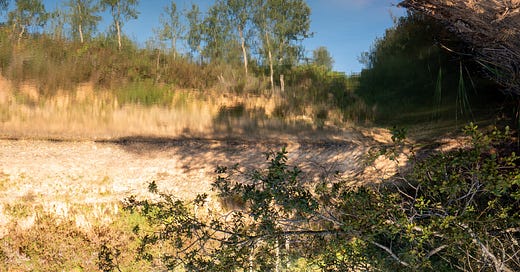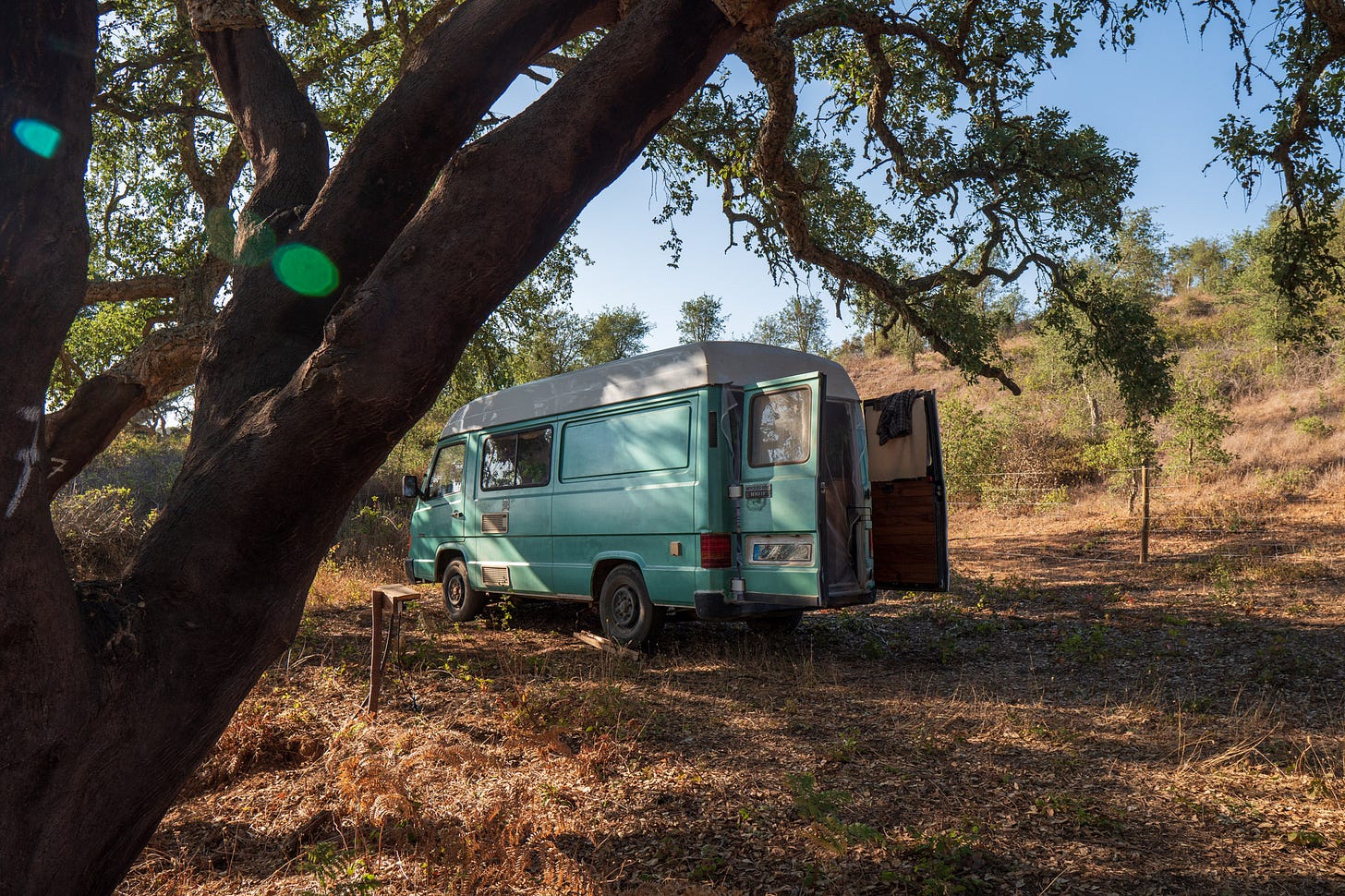Summer Daze
High summer has hit Portugal, bringing with it the ferocious heat and wildfires that this country is known for. This is the tale of life in an incendiary land.
Dust clouds fill the air, swirling and dancing in the desert winds that blow across the ocean from Africa. Summer is here—how much has changed. When I left back in April, the spring rains had come, bringing with them the vibrancy of life that only an abundance of fresh water could bring. The land was intensely green, dotted with wildflower, the rolling hills covered with yellow lupins. Those same hills now seem a desolate wasteland in comparison. Perhaps that is a harsh statement, but certainly it is justified to an extent by the extreme conditions. The soil is dry is a bone, all that remains of these once-green hills is the lifeless blades of beige grass and the spiked-skeletons of thistle flowers. The herds of sheep sit in every inch of shade they can get, hiding from the relentless Alentejo sun—no doubt suffering as much as the rest of us, if not more. These are the days of forty degrees celsius, of intense dry heat, where the punishing ultraviolet rays cut through anything and everything that stands in its way.
Despite the harsh conditions, I am content. I've found a spot underneath some ancient cork oak trees, sheltered and protected from the elements. Nestled into the side of a small valley where we began our journey—the Barranco da Lage, María the van rests patiently, no doubt relieved to no longer deal with these long distance road trips. I’m sure if dogs could talk, then Lupa would express similar sentiments. If I attempt to count the figures of distance covered, I lose track. This year probably exceeds eight thousand kilometres alone so far. Since the speedometer is broken, the van stopped counting distances a long time ago. Probably for the best, I’d say. Despite the occasional breakdown, the past eighteen months of adventuring have proven a pretty good track record for a thirty year old van that cost me only three thousands euros.
Each day, the small pond on this large plot of land seems to be the only thing that retains my remaining sanity amidst the soaring temperatures. Having a spot like this to cool down in is a huge relief in times like these—that is, if you don’t mind sharing with the frogs and water snakes. I take off my shoes and slide down the clay banks, submerged in an instant by the cool waters. The owner of the land walks past the few of us who are swimming in the pond and exclaims: “Enjoy, this is the last water left in Alentejo!” with a sense of irony, half joking and half serious. The lack of water is a real issue out here, one that is causing widespread concern. Wells are running dry and the rivers stopped flowing a few months ago. Humour seems to be an appropriate way of dealing with the pervasive climate anxiety.
It’s the fourth consecutive day above forty degrees. The heat permeates every cell of my body with its unrelenting intensity. If it weren't for the strong winds blowing from the south, today would be intolerable—but one person's blessing is another's curse. I was walking along the dirt track after swimming in the pond once again, noticing a haze of fire smoke in the air. The cloud of smoke hung over the valley like an ominous mist. Never a good sign in the height of summer in Portugal. I talked to one of the neighbours and he said a wildfire had started in Algarve yesterday, getting out of control overnight. They know someone who just lost their land to this fire. One spark and it’s gone. This is fire season, and it leaves everyone on edge. We are living on incendiary land.
Today, I’m heading out on a bike ride with my friend Peter, who moved here to Alentejo from the Netherlands fifteen years ago to build a new life in nature with his wife, Joke. We head out early to avoid the worst of the mid-summer heat. I ask how he is coping with the changes in climate over the past few years. He tells me that he has three wells on his land, one of which used to overflow with water until three years ago. Since then, he has been watching the water levels on his land sink lower and lower each year. The cork trees that inhabit his valley are dying, most likely due to drought. The climate here is indeed changing. My mind drifts back to a recent bike ride where I saw a local farm growing opuntia, more commonly known as prickly pear cactus. Surely a sign of changing times—an adaption made by the farmers to the desert-like environment that this place is becoming.
We continue on our adventure, up over the hills surrounding São Luis, where most of the landscape has been degraded into eucalyptus plantations. These places feel like a graveyard. What was once before a thriving, biodiverse Mediterranean forest has now been decimated into a lifeless monoculture—an area transformed by greed and cash-crop agriculture. The rocky terrain brings my attention back into the present. We head upwards, ascending the ridge that separates the coastal lowlands from the rolling hills and valleys of inland Alentejo. This area is considered part of the Parque Natural do Sudoeste Alentejano e Costa Vicentina, a natural park that eclipses the entire southwest of Alentejo and the Algarve, intended to protect the natural flora and fauna that calls this wild coastal landscape home. Given that the entire area around the Rio Mira is entirely engulfed in eucalyptus plantations, it’s hard to imagine that this is considered a protected a natural area. Perhaps a redefinition is in order: protected, until someone waves enough cash in the faces of bureaucratic officials to convince them otherwise. Such is the way of the world.
We crest the summit of the ridge line, with a panoramic view that reaches all the way until the Atlantic ocean. Peter point to the left and explains that this gravel track leads down to the old mine of Cercal, once used for extracting iron and manganese. I insist that we have to go and check it out. My days of urban exploration are a thing of the past, but the curiosity that drove it is still very much present. The trail is bumpy and rocky, the line must be picked carefully in order to stay on the bike. We turn a corner, through a canopy of stone pine trees, also known as umbrella pines, for their upside-down umbrella shape. The sweet smell fills the air. Some ruins come into view and it seems we have arrived at the Serra do Rosalgar mine. This valley is incredibly serene, certainly not what I was expecting from an abandoned mine. Some very old cork trees surround the derelict buildings, as well as fruit and olive trees. A small herd of black goats are grazing on the grass, their bells ringing softly, the peaceful sounds reverberating through the valley. My mind drifts back to exploring an abandoned coal mine in the Brecon Beacons—how it felt to be in a place with a pervasive heavy atmosphere, knowing that miners had lost their lives in those deep mineshafts. This is quite a contrast indeed. I could even imagine living a hermetic existence here, if it wasn’t for the likely pollution that has resulted from the mineral extraction.
I head towards the opening of the mine—a black hole, an abyss. I feel the vacuum of cold air hit my face as I walk closer. An old catholic shrine sits by the doorway. I look up and I see a cluster of spiders on the ceiling, it sends a shudder down my spine. I can see that the tunnel is blocked further down and I decide to retreat, back into the safety of daylight and the warmth of the open air.
We leave the mine and descend back down into the valleys, flowing through the cork forests. I notice the subtle remnants of how this land once was. The few areas that remain untouched have an indescribable quality of natural beauty. These valleys are vibrant, green and teeming with life. Small amounts of fresh water remain, probably the last of what hasn’t been sucked up already by relentless eucalyptus farming. Much like the Algarve, this natural landscape is in many ways a shell of its former self. Small fragments of wildness remain, giving hope that we can once again return to the biodiversity that once was.
The next day, I am back in the swimming pond once again. A few of us are cooling off in the waters. We can see smoke in the sky, similarly to before. Except this time is different, since the smoke is coming from much closer. Indeed, the threat is real and tangible. We can see the fire-fighting helicopters in the sky, as the bombeiros fly back and forth to the Rio Mira, collecting water in giant buckets in order to dampen the flames. Anton, the owner of a local café arrives at the pond for a swim with his dog. He informs us that the fire is local—coming from Castelão, only a kilometre or so away from where we are now. Apparently, the farmer’s field is on fire and the locals are digging up the edges of the land to stop the blaze from spreading. Anton assures us that the flames are under control, and sure enough, the helicopters disperse after a few journeys between here and the river. Life goes on, I suppose.
These are strange days, where these apocalyptic themes have now become commonplace—where severe droughts, intense heat and risk of wildfires are the new normal. I’ve never liked normal anyway. Normal is mediocrity and half-heartedness in disguise. We have to collectively aspire to more—aspiring to resist the tyranny of big business and hyper-industrialism, extractive economies and consumer culture, the entities that are driving the collapse of the biosphere—the degradation of the land, water and air, causing our natural equilibrium to swing out of balance. How far will it go until we decide to make sincere and radical changes, both on a collective and individual level? It’s time to realign our values with that which supports life, instead of that which destroys it.






We just came out of a heat wave in Ontario too... the climate is definitely changing.
I can't imagine being that close to a fire, that doesn't happen often where I live, though I've got friends in the west who experience it annually. That's so scary. I'm glad everyone you were with is okay.